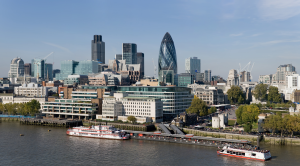 London plans to become the ‘world’s most walkable city’ under a new plan unveiled by the capital’s first-ever walking and cycling commissioner, with its ‘Walking Action Plan – which is being supported by Public Health England – aiming to encourage a million additional walking trips each day by 2024.
London plans to become the ‘world’s most walkable city’ under a new plan unveiled by the capital’s first-ever walking and cycling commissioner, with its ‘Walking Action Plan – which is being supported by Public Health England – aiming to encourage a million additional walking trips each day by 2024.
image: By © David Illif, User:Colin and Kim Hansen /
Wikimedia Commons, CC BY-SA 4.0,
https://commons.wikimedia.org/w/index.php?curid=48935922
The Mayor of London and London Assembly write:
London’s first ever walking and cycling commissioner, Will Norman, has unveiled the capital’s first Walking Action Plan. It sets out how London will become a city where walking, for those that can, is the most obvious, enjoyable and attractive means of travel for all short trips.
The plan, which is supported by Public Health England (PHE), has an ambitious vision to make London the most walkable city in the world, with a million extra walking trips taking place each day by 2024*.
The Mayor of London wants to increase the proportion of people walking, cycling and taking public transport to 80 per cent of journeys by 2041, from 63 per cent now. And the Mayor is investing a record £2.2bn in streets across London to make them better for walking and cycling, and improve air quality.
Walking is an easy and affordable way for Londoners to integrate more physical activity into their daily lives. However, research shows that too many people are put off because of concerns about road danger or worries about their levels of physical fitness.
The Walking Action Plan aims to help Londoners overcome these barriers by:
- Designing, building and managing streets for people walking, by delivering better public spaces, more walking routes and more numerous and wider pedestrian crossings
- Ensuring that walking is prioritised in every new infrastructure scheme, through London’s first ever pedestrian design guidance anda range of other tools and analysis to support boroughs to deliver local schemes
- Enabling thousands more children to walk to school by doubling the number ofGold accredited STARS schools which champion healthy routes to school, and by supporting timed road closures, car free days and 20mph speed limits around schools
- Rolling out innovative new traffic signal technology that makes it safer and easier for pedestrians to cross roads, while minimising congestion
- Creating new ‘Active Travel Hubs’ at London Underground stations, making it easier to walk as part of an onward journey
Major projects are already underway to enable more walking across London, such as Highbury Corner, where a new public space and new pedestrian crossings are being installed, and at Old Street where work will begin to transform the roundabout in 2019.
The experience of pedestrians will also be improved around Swiss Cottage with new crossings and the removal of the dangerous gyratory. And in Kingston, TfL funding is helping to deliver improved pedestrian and cycling routes between the town centre and the riverside.
Close partnership working is crucial in delivering a better walking experience across the capital, which is why TfL is supporting London’s boroughs to deliver attractive, healthy and safe streets, including the £115 million Liveable Neighbourhoods programme, with the first seven projects starting in 2018.
London’s first ever Walking Action Plan comes alongside the Mayor introducing bold and widespread measures to clean up London’s air. This includes the Mayor launching the world’s first Ultra Low Emission Zone (ULEZ) which puts in place minimum emission standards for vehicles, spending more than £300 million transforming London’s bus fleet, and making sure TfL no longer licences new diesel taxis from this year. The Mayor has already introduced an emissions surcharge – or ‘T-charge’, meaning vehicles must meet minimum exhaust emission standards, or drivers have to pay a daily £10 charge in addition to the Congestion Charge.
